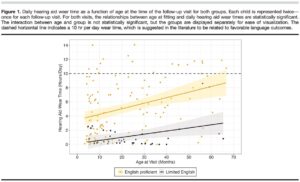Pediatric Hearing Aid Daily Wear Time
Pediatric Hearing Aid Daily Wear Time Is Significantly Impacted by Clinician-Family Language Discordance
Authors: Nicole Brigham, Emily C. Thompson, Erin M. Picou, Hilary Davis, and Anne Marie Tharpe
 RESEARCH QUESTIONS: The purpose of this study was to evaluate the potential contribution of limited English proficiency on daily hearing aid wear time for children with hearing loss. Our research question was: do children from families with limited English proficiency use their hearing aids fewer hours per day than children from families who share proficient English ability with their audiologist?
RESEARCH QUESTIONS: The purpose of this study was to evaluate the potential contribution of limited English proficiency on daily hearing aid wear time for children with hearing loss. Our research question was: do children from families with limited English proficiency use their hearing aids fewer hours per day than children from families who share proficient English ability with their audiologist?
 WHAT WE DID: We conducted a retrospective chart review to evaluate hearing aid wear time based on data logging information at the time of a follow-up visit following an initial hearing aid fitting. Children in the study had permanent bilateral hearing loss and were less than 60 months of age at the initial visit. The presence of an interpreter was used as the study indicator that the family had limited English proficiency.
WHAT WE DID: We conducted a retrospective chart review to evaluate hearing aid wear time based on data logging information at the time of a follow-up visit following an initial hearing aid fitting. Children in the study had permanent bilateral hearing loss and were less than 60 months of age at the initial visit. The presence of an interpreter was used as the study indicator that the family had limited English proficiency.
WHAT WE FOUND: We found that children from families with limited English proficiency exhibited significantly shorter daily wear time (M = 1.3 hr) than their peers whose families were English-proficient speakers, thus, having a shared language with their audiologists (M = 5.2 hr). Figure 1 displays the children’s mean daily hearing aid wear time as a function of age for families identified as English-proficient (gold) and limited English proficiency (black).

IMPLICATIONS: The majority of children (approximately 80%) in this study wore their hearing aids less than the recommendation of 10 hours per day, which is associated with better language outcomes. Pediatric audiologists might contribute to improvements in hearing aid wear time by providing clear and understandable instructions and using novel counseling tools. Specific to children from families with limited English proficiency, accessible written materials should be provided, professional interpreter services should be prioritized, and families can be connected with other families with similar cultural backgrounds. Finally, there should be an effort to diversify the field of audiology to better reflect the diversity of the families served, in particular an increase in the number of billingual providers would be desirable to serve families with limited English proficiency and may also decrease financial and logistical barriers related to interpreter services.
Brigham, N., Thompson, E. C., Picou, E. M., Davis, H., & Tharpe, A. M. (2024). Pediatric Hearing Aid Daily Wear Time Is Significantly Impacted by Clinician–Family Language Discordance. American Journal of Audiology, 1–9. https://doi.org/10.1044/2023_AJA-23-00043